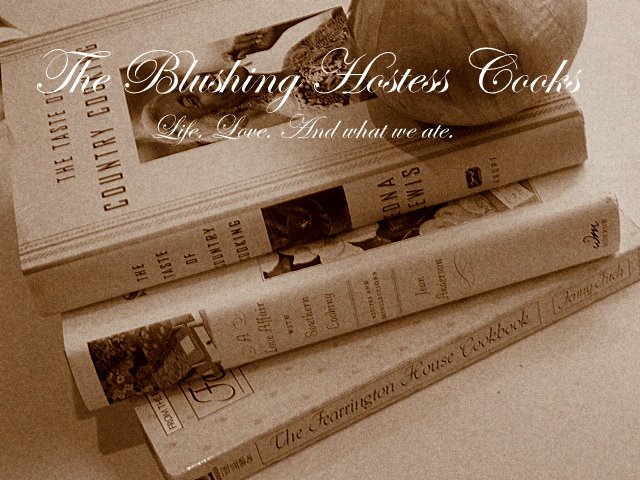Afternoon, Friends.
It never ceases to amaze me the way dishes go by. One of the many reasons I began Blushing Hostess was to chronicle my cooking life and the recipes and garden yields that influenced the dishes we ate. In a collection of cookbooks I keep towards the bottom of the shelves, there are thousands of worthy recipes. Though, they have for a few years now seemed to me more recipes gone by, if you will, than current and influential.
I know restaurants that seem to cook from these very cookbooks. They have commanding and moving views of the Boston and Cape Cod shorelines, old captains chairs for seating, and thin red-patterned worn carpets. They smell a little shore-line musty, smack of another time when people actually wore dinner jackets while eating out on vacation and dining with ladies with bouffant hair, sheath dresses made of thick polyester fabrics and wearing big plastic beads for necklaces. They served dishes of a legendary and high order that go by names youthful trendy diners have little connection to: Newburg, Thermador, Imperial, and Diane to name a few. It was an age of thick white sauces, fish covered in butter, then sprinkled liberally with cracker crumbs and more butter before being passed for mere seconds under a broiler. There was a time this was some pretty haute grub, okay? I'm young, but not so young as not to remember eating a Oscar this or an Imperial that. The truth of the matter, as I have intimated plainly to you, is that some places of this ilk remain. And the truth of me is that sometimes, I seek comfort in the things I associate with my first fine dining moments with my extended family.
It is ever so rare these days that I would pick up any cooking magazine and see one of these old fat-laden, heart-attack threatening renditions of butter, more butter, wine, stock, and cream. Oh, but there are days I want them back fiercely if only to uncloak a primary truth about restaurant food of this near age: Just because it looks healthier than the old days does not mean that it is. Restaurant food is not, for the most part, intended to help you govern your health. It is intended to taste fabulous in order to bring you back again and again. It is intended to make you crave something they do well.
Here are a couple more painful facts but facts nonetheless: Truly good steak is finished in butter. Tasty sauces are finished in cream, or butter. Salt punches up the flavor of everything when used correctly (Don't believe me? When you bake that next batch of chocolate cookies, sprinkle some grey sea salt over the top just as they come out of the oven.) If you are eating rich foods, restaurant or not, in moderation these occasionally creamy buttery bursts on your tongue will not be your greatest undoing. If you are eating them with abandon every night, why, you may have yourself a problem by next week. The point is, while the names and cooking techniques vary from the age of smoke-filled seaside joints, the fact of caloric and concerning ingredients remains.
But if, in the course of a moderate and careful life, you occasionally wish for a beautiful plate of food which is admittedly not the lowest in calories but is the highest in gorgeous, old-restaurant with a view of the Cape shore-comfort, make this dish. Or make it, for a guy named Mr. Micheli, who years ago sent it into Gourmet magazine in remembering his mother. I imagine her with a lovely big do, a sheath dress, and wearing a big necklace. I too make this in her honor, and in honor of the way it was.
Chicken (or Halibut) Louisa
Serves 4
adapted from Mr. Micheli's recipe as published by Gourmet, 2000
I occasionally use fish steaks of halibut here to make it special but Mr. Micheli, that old fox, he used boneless chicken breasts to make it a thing you could make on a Tuesday night. And you will be fine with dried tarragon though, tarragon is a lovely thing to have in a kitchen garden for salads and pot pie crusts, just off the top of my head...
4 (1/3-inch-thick) chicken cutlets
(1 1/2 lb)1 tablespoon olive oil
1 tablespoon unsalted butter
1 medium shallot, finely chopped
1/2 cup dry white wine or dry vermouth
1/2 cup chicken broth
3/4 cup heavy cream
4 or 5 plum tomatoes, coarsely chopped
2 tablespoons finely chopped fresh tarragon
1/2 extra-large chicken-bouillon cube, crumbled
Preheat oven to 200 degrees.
Pat chicken dry and season with salt and pepper. Heat oil and butter in a 12-inch heavy skillet over moderately high heat. Brown chicken on both sides in 2 batches, about 6 minutes per batch. Transfer chicken to a plate and keep warm in the oven until ready to serve.
Add shallot to skillet and cook, stirring, until tender, about 1 minute. Add wine and deglaze by boiling over high heat, scraping up brown bits, until reduced by half. Stir in broth, cream, tomatoes, and tarragon. Simmer, stirring, until tomatoes are softened and sauce begins to thicken, about 6 minutes. Season with salt and pepper.
Return chicken, with any juices accumulated on plate, to skillet and simmer until cooked through. Serve with rice.
Thursday, July 24, 2008
Subscribe to:
Post Comments (Atom)







No comments:
Post a Comment